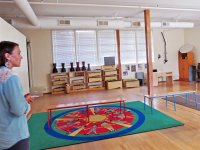Mindful Facilitation: Don’t Do Something, Just Stand There
To help students find their own way in PBL, use mindfulness techniques like tuning into your own body, nonjudgmental observation, and embracing the “don’t know” mind.
Your content has been saved!
Go to My Saved Content.Editor's note: Susan Dreyer Leon, a board member of the QED Foundation and the Vermont Insight Meditation Center, co-authored this post.
In a PBL classroom, students do things. But what about the teacher? What do we need to be doing while the students are doing things? What does it look like when the teacher is a coach? Are we still doing things, and if so, what are they? In Making Space for Thinking, we made the case that good facilitation is largely an internal process of observation, data collection, and questioning that, while it requires the full attention of the teacher, looks a lot like "standing around drinking my coffee, watching the kids." We may worry, "What if my principal walks in and sees me not doing things?" So we get into the middle of student processes, correcting and nudging and answering questions before we need to, because that's what we think teaching is -- doing things.
What if we took a page from the mindfulness community and chose to not do things, but rather to be present with whatever's happening around us and within us? Here are five things that you can do now, no matter your level of experience with mindfulness, to become a better facilitator.
1. Pause
Claire Stanley defines this as "a moment taken intentionally before one begins." The PBL classroom is busy -- it's hard to focus our own attention. Rather than rushing headlong between groups and tasks, take a pause. Pause before you jump into a group's process, before you gather the class for an announcement or new information, between talking with one student and the next. Create a tiny space and see what difference that makes.
2. Just One Breath
Try to be present in your body for just one breath. This technique can be used during your pause or in any moment when you feel anxious or too busy (which is sort of all the time for most of us). PBL classrooms, especially as students are learning to be more self-sufficient, are filled with questions. One conscious breath before answering can give you the time that you need to relax. Then you can choose a response with more care. You can decide whether you even need to answer the question at all. Consider suggesting that your kids wait for one breath before they ask -- they may realize that they already know the answer!
3. Tuning Into Your Body
You can stop at any moment and ask yourself, "What is happening in my body right now?" How often do we find ourselves feeling crabby and frustrated with our students just before lunch, at the end of the day, or when our classrooms are too hot or too cold? It's amazing how often we can transfer physical discomfort -- hunger, exhaustion, pain -- into frustration with our students. Just acknowledging we may have a headache or feel anxious about time can help us be less reactive. Checking in with our physical selves can help bring us back to the present moment and keep us from overreacting or losing our cool with the kids.
4. Nonjudgmental Observation
"Paying attention on purpose, in the present moment, and nonjudgmentally" is a commonly-cited definition from Jon Kabat-Zinn, and one that can be very helpful. When kids are moving through a well-designed PBL experience, what we see is often unexpected. The nimbleness of our responses can make a big difference in how much risk students are willing to take and how much they're able to accomplish. By asking ourselves, "What is really happening right now?" we can separate our expectations of what we think should be happening from what is actually taking place, without labeling what we see as right or wrong, good, or bad. If you're thinking, "The kids are doing that wrong, I need to go redirect them or fix it," you're bound up in your idea of what should be rather than what is, which means that you're less available to help them with their ideas. If we're always trying to make sure that they do it our way -- the expected way -- we're never going to get anything new. Nonjudgmental observation allows us to say, with curiosity and interest instead of worry, "That's interesting. I wonder how it's going to work for them."
5. "Don't Know" Mind
This way of thinking, also sometimes called beginner's mind, is the essence of PBL done well for both teachers and students. It's the space of openness and childlike delight in the new, the unpredictable, the infinite variety that humans bring to their efforts, and the myriad ways that we approach problem solving and the creative process. The "don't know" mind is a delight in letting go of control and accepting the limitations of our own perspective and conditioning. We embrace the idea that our students might actually know some things that we don't.
Give one of these mindful facilitation strategies a try in your classroom and let us know how it goes. In the comments section of this post, add your own techniques and tools for staying in the moment with your kids, and let's see what we learn from each other!
